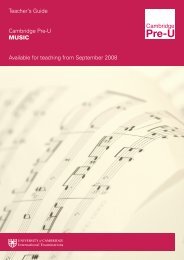Cambridge Pre-U Syllabus - Cambridge International Examinations
Cambridge Pre-U Syllabus - Cambridge International Examinations
Cambridge Pre-U Syllabus - Cambridge International Examinations
You also want an ePaper? Increase the reach of your titles
YUMPU automatically turns print PDFs into web optimized ePapers that Google loves.
42<br />
<strong>Cambridge</strong> <strong>Pre</strong>-U Draft<br />
Section A will consist of one or two questions totalling 45 marks. It should be completed in about 90<br />
minutes. It will include an experiment or experiments requiring candidates to collect quantitative or qualitative<br />
data, to draw up tables, charts, graphs and other appropriate means of presenting the data and to analyse it<br />
to draw appropriate conclusions and evaluate procedures and data.<br />
It will focus on the following experimental skills:<br />
• manipulating apparatus;<br />
• decision-making;<br />
• recording observations and measurements;<br />
• presenting data;<br />
• calculating, e.g. rates of reaction;<br />
• analysing data – describing experimental results, observations and secondary data;<br />
• concluding.<br />
• evaluating procedures and data;<br />
• suggesting improvements;<br />
Apparatus requirements for Section A<br />
The apparatus requirements for Section A will vary from paper to paper. A complete list of apparatus and<br />
materials required for each question will be issued in the Confidential Instructions. The Confidential<br />
Instructions should be followed very carefully. If there is any doubt at all about how practical examinations<br />
should be set up, it is vital that Centres contact CIE as soon as possible.<br />
To give some variation in the questions set, some novel items or equipment or materials may be required.<br />
The list of practical apparatus and materials later in the syllabus gives details of the requirements that are<br />
frequently required. Candidates should be accustomed to using these.<br />
Section B will consist of one or more short questions totalling 35 marks. It should be completed in<br />
60 minutes. The questions will test the candidates’ abilities to make observations and present, analyse and<br />
interpret their findings. Candidates will be expected to use a microscope to observe and draw from<br />
histological specimens that they have made themselves as temporary mounts or which are provided as<br />
prepared slides. Candidates will also be provided with secondary data to analyse and interpret. This<br />
secondary data may be in the form of photographs, drawings, diagrams, tables and graphs. Section B will<br />
concentrate on the following skills:<br />
• decision making<br />
• observing<br />
• presenting information in the form of plan diagrams, drawings, tables, etc.<br />
• calculating, e.g. magnifications and actual sizes<br />
• analysing data – describing and interpreting experimental results, observations and secondary data<br />
• evaluating.<br />
Throughout their course, candidates should be given opportunities to make decisions about their practical<br />
work. This might involve choosing the number of values of the independent variable and the number of<br />
replicates. It might also involve deciding how to make up dilutions. They should also plan complete<br />
experiments to include methods of data collection and analysis. Candidates taking the practical examination<br />
will be expected to have the appropriate skills involved in decision-making and planning even though<br />
candidates will not be expected to plan a complete experiment in this examination.

















